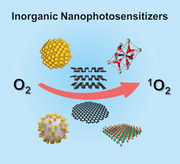- Record: found
- Abstract: found
- Article: found
Inorganic Nanomaterials with Intrinsic Singlet Oxygen Generation for Photodynamic Therapy

Read this article at
Abstract
Inorganic nanomaterials with intrinsic singlet oxygen ( 1O 2) generation capacity, are emerged yet dynamically developing materials as nano‐photosensitizers (NPSs) for photodynamic therapy (PDT). Compared to previously reported nanomaterials that have been used as either carriers to load organic PSs or energy donors to excite the attached organic PSs through a Foster resonance energy transfer process, these NPSs possess intrinsic 1O 2 generation capacity with extremely high 1O 2 quantum yield (e.g., 1.56, 1.3, 1.26, and 1.09) than any classical organic PS reported to date, and thus are facilitating to make a revolution in PDT. In this review, the recent advances in the development of various inorganic nanomaterials as NPSs, including metal‐based (gold, silver, and tungsten), metal oxide‐based (titanium dioxide, tungsten oxide, and bismuth oxyhalide), metal sulfide‐based (copper and molybdenum sulfide), carbon‐based (graphene, fullerene, and graphitic carbon nitride), phosphorus‐based, and others (hybrids and MXenes‐based NPSs) are summarized, with an emphasis on the design principle and 1O 2 generation mechanism, and the photodynamic therapeutic performance against different types of cancers. Finally, the current challenges and an outlook of future research are also discussed. This review may provide a comprehensive account capable of explaining recent progress as well as future research of this emerging paradigm.
Abstract
Inorganic nano‐photosensitizers possess higher extinction coefficient, resistance to photobleaching, larger absorption cross‐section, and high singlet oxygen quantum yield than their organic counterparts. These fascinating physiochemical features endow them with promising potential for reactive oxygen species‐mediated photodynamic tumor cell killing, antibacterial therapy, thermal ablation‐induced antitumor photothermal therapy, and simultaneous tumor diagnosis and treatment for multimodal cancer theranostics.
Related collections
Most cited references5
- Record: found
- Abstract: not found
- Book: not found
Nanomaterials in catalysis
- Record: found
- Abstract: not found
- Book: not found
Catalysis by Materials with Well-Defined Structures
- Record: found
- Abstract: not found
- Book: not found
